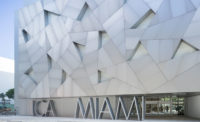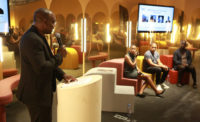Design Miami 2017: Art Meets Architecture at the Jade Signature, the Bass Museum, and ‘Form and Space’

Jade Signature by Herzog & de Meuron
Photo © Graciela Cattarossi

“Richard Meier and Frank Stella: Space and Form” at the Meier Gallery
Surfside, Florida
Photo © Graciela Cattarossi

“Richard Meier and Frank Stella: Space and Form” at the Meier Gallery
Surfside, Florida
Photo © Graciela Cattarossi

Jubilee Church sketch by Richard Meier
Photo © Graciela Cattarossi

Bass Museum of Art expansion and renovation by David Gauld
Miami Beach
Photo © Zachary Balber





Herzog & de Meuron established themselves in Miami Beach with 1111 Lincoln Road a fabulous parking garage that just sold for $283 million (the owner’s top-floor condo is being marketed separately). They went on to design the beloved Pérez Art Museum Miami, also in exposed concrete.
Their latest building, called Jade Signature, is a handsome, 650-foot condo tower with more than 1.2 million gross square feet. Partner Jason Frantzen described orienting the 192-unit building at an angle, to maximize sunlight reaching the beach in the afternoons, and eliminating the garage-in-a-plinth that makes so many large condo buildings unapproachable from the street. (Parking is underground.) “We always look for ways to connect people to nature,” said Frantzen.
There are many Herzog & de Meuron flourishes in the concrete structure, including hourglass-shaped columns and concave projecting walls, though it’s all painted white, for both aesthetic and commercial reasons. The building (with interiors by the Paris designer Pierre-Yves Rochon) is lovely, but it’s still a very big condo building on the beach.
One of best exhibitions I saw was located, somewhat incongruously, in another big condo building on the beach. Called “Space and Form,” it concerns the relationship between art and architecture in a very specific case: the more than 50-year friendship between Richard Meier and the artist Frank Stella, who once shared a studio in lower Manhattan (Meier used the space at night while Stella was out drinking). Former MoMA curator Terence Riley organized the show, which includes work by both men in a variety of media; although Meier (usually) avoids color and Stella (usually) embraces it, the formal overlaps and intersections are striking. Among the gems in the show (which is housed on the ground floor of a new tower by Meier at 9001 Collins Ave. and runs through March 4) are Stella’s designs for the Stations of the Cross at Meier’s Jubilee Church in Rome. They were never realized.
But lots of good work isn't unrealized. If Greg Goldin and Sam Lubell, authors of Never Built Los Angeles and Never Built New York, pursue a Miami sequel, they’ll have plenty of material. Entries would include the plan for a new Miami Beach convention center by Rem Koolhaas and OMA, selected in 2014, then scrapped for a less ambitious plan by Arquitectonica (now under construction). Also: Arata Isozaki’s original, competition-winning scheme for enlarging the 1930s Bass Museum, on Collins Avenue. Only parts of Isozaki’s plan were carried out, making the 2001 version of the museum somewhat dysfunctional. So the Bass returned to Isozaki and his protégé, New York architect David Gauld, to plan a second renovation. The results, which included enclosing an underutilized courtyard and eliminating an oversized ramp, have made the museum more useful, and more beautiful, in time for this week’s opening.








